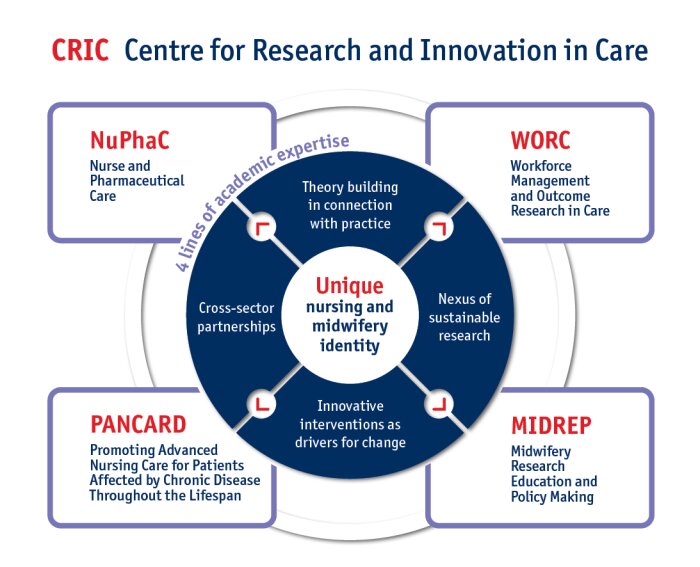CRIC model
-
 CRIC model
CRIC model
The mission of CRIC is to build an excellent team of researchers who are highly successful in providing rigorous evidence for optimizing the quality of nursing and midwifery care provision and related patient outcomes. The four transversal domains (Figure 1) shape the goals of CRIC, as they represent the elements in which CRIC wants to excel.
Firstly, CRIC strives for strong theory building and theory testing research that can include local quality improvement projects, yet transcends the local context to result in generally applicable and evidence-based principles, theories, and models that can support quality improvement of nursing and midwifery at a larger (inter)national scale. Nevertheless, the strong connection with practice (i.e., clinical practice, education, policy) is deemed essential to truly contribute to these fields.
Secondly, CRIC research focuses on innovative interventions as they are considered drivers for change. Based on a thorough investigation of problems at micro-, meso-, and macrolevel, engaging relevant stakeholders and considering different contexts, interventions are developed in co-creation, implemented, and tested. A variety of qualitative, quantitative, and mixed methods research methodologies are applied, including for example analysis of big data, complex interventions, and implementation science. CRIC invests in training researchers in new methods. Striving to deliver high-quality nursing and midwifery care requires the application of a multifaceted approach operating at various levels. In the realm of direct patient care, it is vital to comprehend the array of actions that positively impact patients' well-being and quality of life. For organizing such care provision, factors such as care efficiency and team composition are crucial. Through its’ research activities, CRIC aims to gain a profound understanding of the roles, responsibilities, and competencies of nurses and midwives deemed essential for optimizing the deployment of healthcare providers and advancing educational practices.
Thirdly, when involving relevant stakeholders, CRIC aims to establish a broad range of cross-sector partnerships. CRIC reinforces researchers to invest in partnerships, such as interprofessional and transmural collaboration in health care, collaboration with researchers within the faculty and beyond, exploring opportunities to collaborate with other science disciplines, the promotion of patient and family involvement, collaboration with industry, governmental organizations, and international networks. Involving stakeholders from a variety of sectors and domains, CRIC aims to uncover actions to be established in research, education, practice, and policy making.
Fourthly, research activities performed by CRIC aim to serve the nexus of research, education, practice, and policy making. In our goal to make a difference, in close connection to practice, based on strong theory-building, by developing and testing innovative interventions as drivers for change in a connection of cross-sector partnerships, we act on the nexus of research, education, practice and policy making. Investments in these domains reinforce each other and increase the sustainability of our actions.
CRIC's activities encompass a diverse range of target groups and involve a variety of healthcare settings. Nurses and midwives play vital roles in the care for various patient populations and settings. While these settings may differ significantly, there are common overarching themes that define the care provided. CRIC actively facilitates the translation and transfer of knowledge, empirical insights, and best practices from one setting to another, fostering cross-pollination of expertise and experience. Throughout the years, in line with its’ unique mission and transversal domains, CRIC has established four specific lines of academic expertise (See Figure 1).